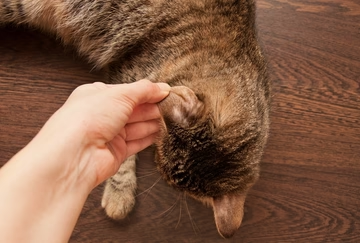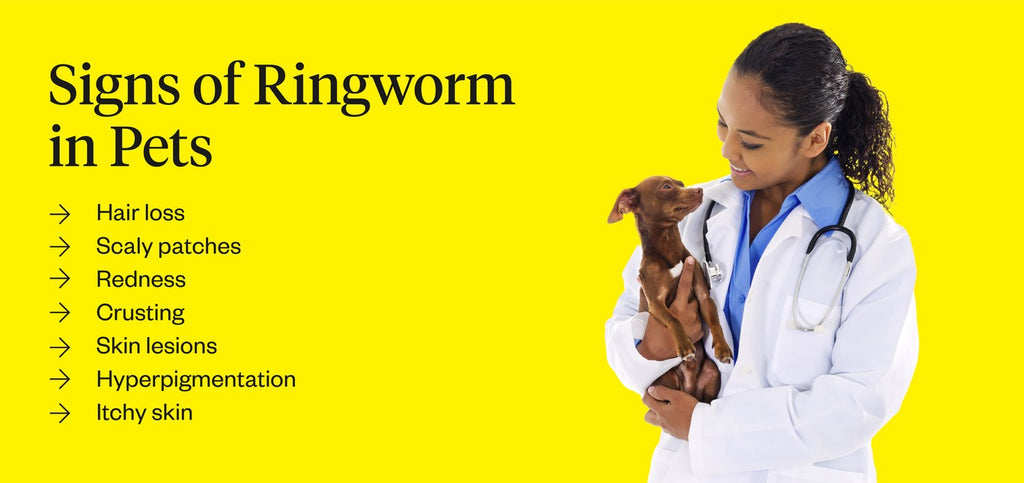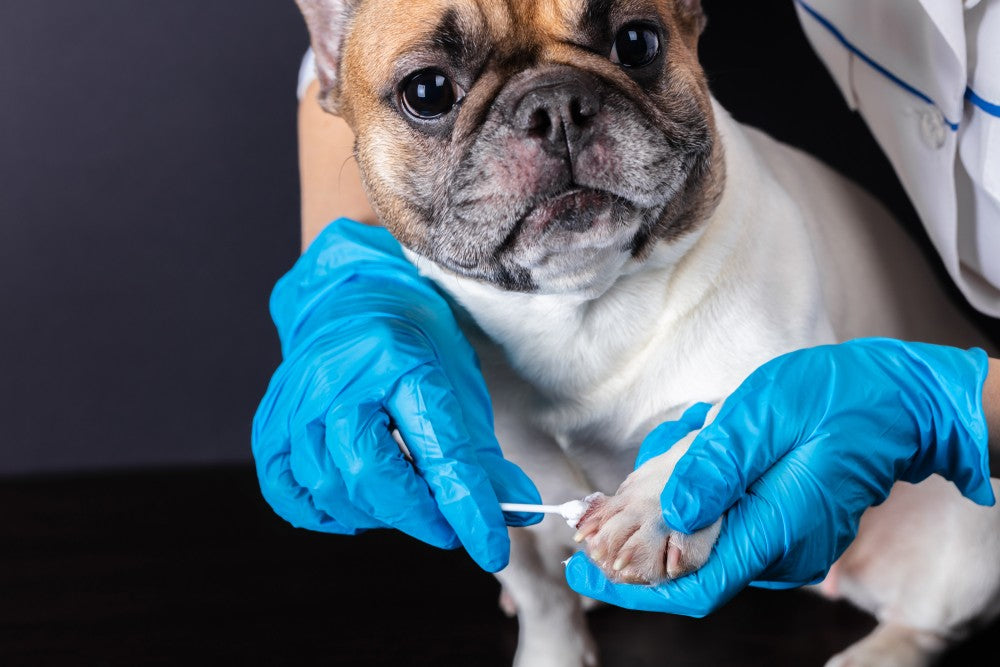8 Min Read
What Does Ringworm Look Like On Pets?
Key takeaway

Why pet owners are switching to online vet care with Dutch
-
Prescriptions delivered free to you
-
Fast access to Licensed Vets over video
-
Unlimited video visits and follow-ups
Ringworm is a type of infection you can’t see until it starts to affect the appearance of your pet. Unfortunately, ringworm can cause discomfort in both cats and dogs. Even though ringworm sounds like an internal parasite, it’s actually a fungal infection that often results in fur loss in pets. While ringworm isn’t life-threatening, it can cause discomfort. This article will discuss what ringworm looks like on dogs and cats to ensure you know what it is when you see it and can get your pet to the vet for treatment.
- What Is Ringworm?
- What Does Ringworm Look Like on Pets?
- Is Ringworm Contagious to Humans?
- How to Treat Ringworm on Pets
- Preventing the Spread of Ringworm Among Pets
- Final Notes
What Is Ringworm?
Even though ringworm sounds like a parasite, it actually has nothing to do with worms at all. Instead, ringworm is a fungal infection of a cat or dog’s skin, hair, and claws.1 The fungus responsible for ringworm is called dermatophytes, which originate in soil but can be found anywhere.2 Ringworm fungi digest keratin, a protein that acts as the building blocks of hair and nails.2

As they continue to consume keratin, the fungi reproduce and create spores. In cats and dogs, most ringworm cases are caused by Microsporum canis fungus.3 However, ringworm can be caused by three different types of fungi, including:
What Does Ringworm Look Like on Pets?
Ringworm looks similar on dogs and cats, and it can easily be mistaken for other types of skin infections, including skin allergies, dog dermatitis, and skin irritation. Ringworm is a type of fungal skin infection and typically doesn’t require treatment in healthy animals.4 However, treatment can help shorten the term of the infection and prevent ringworm from spreading from animal to animal or animal to human.4 Additionally, young or stressed animals are more prone to infection, specifically those in crowded homes.4 Typically, signs of ringworm in cats and dogs include hair loss, crusty skin, scaling, and hyperpigmentation.4 However, ringworm may manifest differently in dogs and cats.

What Does Ringworm Look Like on a Dog?
Ringworm in dogs can be visible in a few ways, including:
- Itchy skin
- Inflammation and red skin
- Rashes
- Scabs or scales
- Circular areas of patchy hair loss
Your dog may exhibit one or more of these symptoms if they’re infected with ringworm. Some dogs may have gray, scaly patches of hair loss, while others have itchy or inflamed skin. Dogs with ringworm typically develop bald, scaly patches of skin, but they may also develop bumps on their skin.1 While ringworm symptoms can manifest anywhere, the most common places of ringworm on a dog are the face, ears, tail, and feet.1

What Does Ringworm Look Like on a Cat?
Ringworm in cats looks similar to ringworm in dogs. However, the most common sign of ringworm in cats includes circular areas of patchy hair loss, broken and dull hair, scaling or crusty skin, and inflamed skin.2 Cats may also excessively groom and scratch.
Kittens are most likely to be infected by ringworm, but cats typically get ringworm on the face, ears, tips, tail, and feet, similar to dogs.3 Unfortunately, long-haired cats may not show signs of infection because their fur covers areas of patchy hair loss or inflamed skin.5
Looking at pictures of ringworm in cats can help you determine whether your cat has ringworm or another skin condition.
Is Ringworm Contagious to Humans?
Humans can get ringworm from their pets. Ringworm is typically spread by contact with contaminated objects or infected animals.1 Ringworm infections in humans typically clear up on their own without the need for treatment, but treatment can reduce recovery time and prevent the fungus from spreading around the house.1 This also means that humans can pass ringworm to their animals and other humans. If your pet or a family member has ringworm, it’s best to treat them to ensure the infection can’t get passed on. Even though ringworm is not a life-threatening illness, it can cause severe discomfort.
It’s also important to note that exposure to an infected animal or contaminated object may not result in a ringworm infection.4 Ultimately, it takes microtrauma to spread the infection. For example, if you’re trimming an infected dog’s fur and accidentally cut yourself, you can get ringworm from the dog. You can also develop ringworm if your dog accidentally scratches you with an infected nail.
How to Treat Ringworm on Pets
Before treatment can begin, a vet must first diagnose ringworm. Because ringworm has symptoms similar to other skin problems in pets, your vet needs to diagnose it to treat it properly. In most cases, vets will want to rule out the other possible causes of patchy fur, flaky skin, itching, and inflammation. They will closely examine your dog’s medical history to determine if they’re allergic to something new or whether they're suffering from another skin condition.
Ringworm in dogs and cats is diagnosed with a skin culture, which is examined under an ultraviolet lamp.1 Your vet will also perform skin scrapings and view the skin under a microscope or send it out to a lab. The best treatment for ringworm in pets is typically medicated shampoos and dips that can treat your pet’s coat and skin.1
If left untreated, ringworm may eventually resolve on its own.2 However, it’s typically best to treat it as soon as possible to prevent it from spreading to other pets or humans in the same household. Treatment will also help your pet heal faster so they won’t have to deal with discomfort or bald spots that will leave exposed skin.2

Treating ringworm is easy and only requires topical antifungal medications and systemic medication.2 However, if there are any lesions, your vet may prescribe other medications to combat infection.
Cats are typically treated with itraconazole at home, while small dogs can be treated with oral itraconazole, ketoconazole, or terbinafine based on their size.4
Depending on the severity of the infection, your vet may also offer itch relief for dogs or cats to prevent excessive scratching or grooming that can lead to sores and infection. Treatment will also involve cleaning your home to kill the fungal spores your pet has shed in their environment.
Ringworm can last anywhere from a few weeks to several months, but it doesn’t cause permanent damage. The earlier you recognize the signs and have your pet treated, the sooner you can help get rid of your dog’s ringworm.
Additionally, never stop treatment until your vet has determined that the infection is gone. Stopping treatment early means your dog will still have ringworm. Recurrent infections or infections that don’t heal after a few months are likely due to treatment failure, so you may have to continue treatment and decontaminate your environment again to ensure your pet is ringworm-free.6
Remember, even if you continue with your vet’s treatment, your dog can still get a recurring infection if you don’t properly clean your home or if they come into contact with another infected dog after treatment ends. Keeping your home clean and your pet away from other pets with ringworm can help prevent recurring infections.

Preventing the Spread of Ringworm Among Pets
While ringworm is not life-threatening, it is contagious to other pets. Some dogs are predisposed to ringworm infections. For example, hunting dogs, stressed dogs, and those with pre-existing illnesses are more likely to get ringworm. Additionally, any dog with microtrauma to the skin can get ringworm if they’re in the same vicinity as another infected pet or contaminated object.6
Meanwhile, pet parents can take certain steps and precautions to prevent infection in their household. This includes knowing the signs and symptoms of ringworm in pets to minimize an outbreak and having the animal treated as soon as possible. Additionally, it’s best to isolate new pets to help prevent the spread of infection.6
Pet parents should also practice good pet hygiene and keep their dogs and homes safe by bathing their dogs regularly, especially after making new friends at the dog park.
Consider keeping them isolated in a room you can clean easily, such as one without carpet, to help decontaminate your home during your pet's treatment. Additionally, you should wash all clothing, blankets, toys, and other products that have come into contact with your pet to avoid reinfection.
When disposing of your cleaning supplies, consider tossing them into a dumpster or trash bin as soon as possible to prevent spores from traveling throughout your home. You should also continue to wash your pet’s bedding a few times a week while being treated to decontaminate their environment as they shed the fungal spores.
It’s also recommended to avoid touching your pet as much as possible while they’re being treated for ringworm to avoid infection. If you do touch your pet, don’t touch your face or any other part of your body without washing your hands first.
Final Notes
Ringworm is not a life-threatening illness, and dogs with ringworm can still live quality lives. However, ringworm can cause discomfort because it can lead to itchiness, fur loss, exposed skin, and even painful lesions when not appropriately treated. Ringworm in cats and dogs have similar symptoms, but these symptoms may resemble other skin conditions, such as allergies, so it’s always best to visit your vet as soon as possible if you suspect your pet has ringworm. Through specialized tests, your vet can diagnose your cat or dog with ringworm to determine the best course of treatment.
Ringworm is contagious, and your infected pet can pass it on to other pets or humans in your household. Treatment for ringworm in pets typically consists of oral or topical medication that can kill the fungus. However, if you do not take the proper precautions, ringworm can return. Always make sure to thoroughly clean your pet’s environment to prevent recurring infections.
Not sure if your dog has ringworm or allergies? Talk to a Dutch-affiliated veterinarian. With Dutch’s telemedicine for pets, you can help stressed, anxious pets get the care they need without the hassle of going to the vet. Instead, you can talk to a licensed vet from the comfort of your own home and help your pet receive the treatments they need fast.Share
References
-
Merchant, Sandra R. “Ringworm (Dermatophytosis) in Dogs - Dog Owners.” Merck Veterinary Manual, Merck Veterinary Manual, 18 Apr. 2022, https://www.merckvetmanual.com/dog-owners/skin-disorders-of-dogs/ringworm-dermatophytosis-in-dogs.
-
“Ringworm: A Serious but Readily Treatable Affliction.” Cornell University College of Veterinary Medicine, 22 May 2018, https://www.vet.cornell.edu/departments-centers-and-institutes/cornell-feline-health-center/health-information/feline-health-topics/ringworm-serious-readily-treatable-affliction.
-
Merchant, Sandra R. “Ringworm (Dermatophytosis) in Cats - Cat Owners.” Merck Veterinary Manual, Merck Veterinary Manual, 18 Apr. 2022, https://www.merckvetmanual.com/cat-owners/skin-disorders-of-cats/ringworm-dermatophytosis-in-cats.
-
Moriello, Karen A. “Dermatophytosis in Dogs and Cats - Integumentary System.” Merck Veterinary Manual, Merck Veterinary Manual, 18 Apr. 2022, https://www.merckvetmanual.com/integumentary-system/dermatophytosis/dermatophytosis-in-dogs-and-cats.
-
“Ringworm.” Centers for Disease Control and Prevention, Centers for Disease Control and Prevention, 30 Apr. 2014, https://www.cdc.gov/healthypets/diseases/ringworm.html.
-
“Gross – My Pet's Got Ringworm! What Do I Do?” Ringworm in Dogs & Cats | Morris Animal Foundation, https://www.morrisanimalfoundation.org/article/gross-my-pets-got-ringworm-what-do-i-do.
-
“Ringworm in Pets.” CVMBS News, 11 Mar. 2022, https://vetmed.tamu.edu/news/pet-talk/ringworm-in-pets/.
